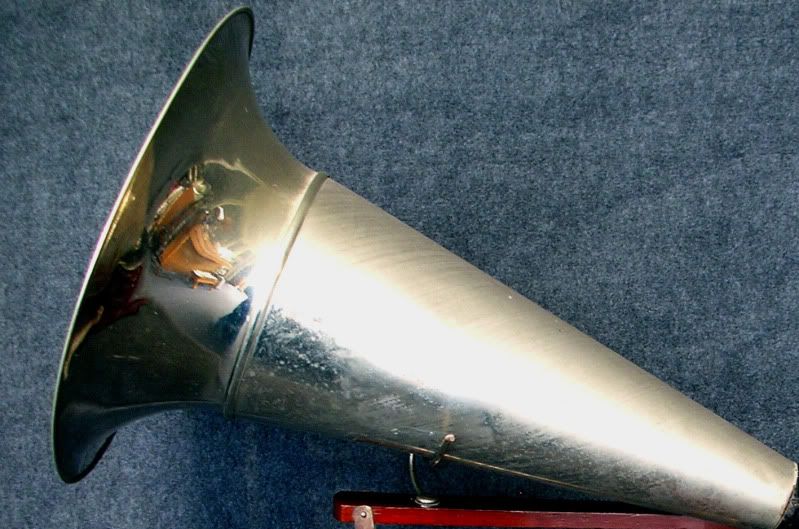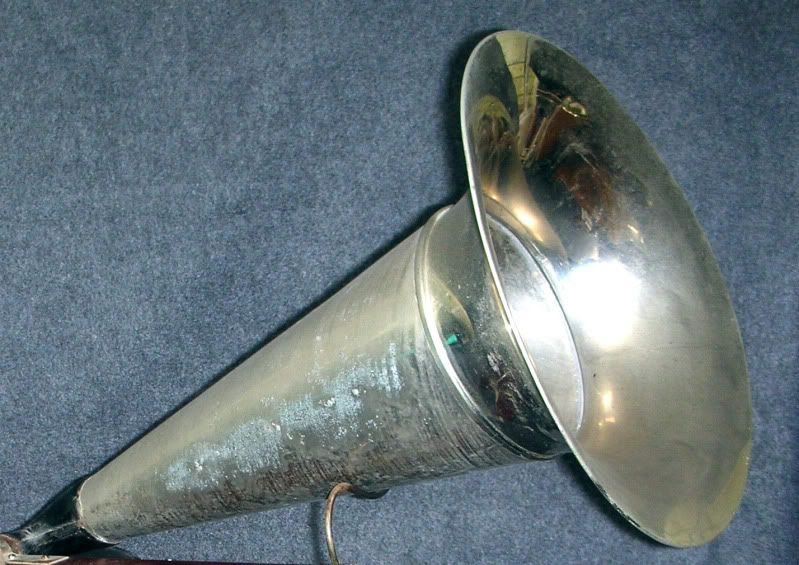Page 3 of 3
Re: Where are the phonographs in Paris?
Posted: Fri Jul 01, 2011 6:03 pm
by TinfoilPhono
My favorite bit of Edison Paris-related material -- an autographed place card from the luncheon presented in Edison's honor in the restaurant Brébant in the Eiffel Tower by the Société des Ingénieurs Civils on Sept. 10, 1889. After the lunch Eiffel invited the guests to a reception in his apartment at the top of the tower, at which time Edison presented the Class M to Eiffel. As they were leaving the restaurant Eiffel noticed composer Charles Gounod finishing his lunch and graciously invited him along, even though Gounod had been one of the fiercest critics of the tower when it was first proposed.
One of the guests at the party prevailed upon Edison, Eiffel, and Gounod to all sign the back of his place card as a souvenir. The party went on all afternoon, with Gounod entertaining on the piano and (no doubt) the phonograph showing its wonders. The story of the luncheon and party is well-described in the book "Eiffel's Tower" by Jill Jonnes -- a delightful book that I can highly recommend to anyone interested in the history of the machine age.

Re: Where are the phonographs in Paris?
Posted: Tue Jul 05, 2011 4:40 am
by Steve
horn of polished copper or nickel-plated, at the customer's choice.
Many thanks for the catalogue scan. I wonder why the French branch of HMV offered mahogany and walnut cabinets and yet Hayes, Middlesex offered either plain oak or plain oak to the UK customer? Were the mahogany cabinets specially made on the continent?
I wonder also if the choice of "polished" or "nickel-plated" finish refers to the same horn? I understand the nickel-plated horns were mainly zinc but why go to the trouble to produce a handful of copper horns as well? Or are they all copper underneath the plating? It would seem logical to me that (in a similar way to brass horns) you might well produce a 'standard' horn in either zinc /brass/copper and then offer it with either nickel plating to make it silver in color or with clear lacquer to enjoy it as it is. But why go to great lengths and presumably additional cost to produce both copper AND zinc horns separately if that was not the scenario?
Re: Where are the phonographs in Paris?
Posted: Tue Jul 05, 2011 5:57 am
by Valecnik
TinfoilPhono wrote:Shipped home. Today it's really tough bringing anything on a plane unless it fits in a carry-on and is
very benign. I once had to leave a security line in Orlando and go check a bag because TSA wouldn't let me carry a small advertising piece on the plane, claiming it could be used as a weapon.

Utter stupidity.
Shipping anything in checked baggage is risky because they do open and inspect many bags, and they don't know how to repack. I once brought a hand-wind Berliner home from Union. I carried the horn and reproducer onto the plane, but the baseboard and turntable were very carefully packed. When I got back I found the turntable shaft, which is pointed, had punched a hole though my laptop because the TSA idiots just tossed everything together without the slightest concern for how carefully I had arranged everything. Today I'd rather just pay Fedex to deliver it to me. In the long run it's cheaper.
I've also had dome real challenges with TSA unwrapping carefully packed items and failing to rewrap properly. Better to carry on if you can. Passing through Schipol airport, Amsterdam in January with my carry on full of wax cylinders, diamond A, M, and a couple of diamond disc reproducers caused quite a ruckus. I was treated very nicely but taken aside until a supervisor could be brought down, then another. Seems the composition of those wax cylinders caused a lot of concern. Even though the first two security guys I dealt with were in thier 50's they'd never heard of a cylinder phonograph or record...
Re: Where are the phonographs in Paris?
Posted: Tue Jul 05, 2011 10:57 am
by TinfoilPhono
Steve wrote:I wonder also if the choice of "polished" or "nickel-plated" finish refers to the same horn?
I do not consider myself an expert in European machines but I don't think these were the same. I had a mahogany trademark previous to this one that had a nickel-plated horn. There was a very distinct difference between the metal of the horn's body and the bell. It is my considered opinion that the body was zinc and the bell nickel-plated brass. The plating held up far better on the bell than the body, and the overall feel, weight, and sound (when tapping the metal) of the sections was very different. The copper horn is heavier than my previous horn was. While I'm not about to do a scratch test, I'm inclined to believe it is solid copper and not plated.
Re: Where are the phonographs in Paris?
Posted: Tue Jul 05, 2011 1:35 pm
by Starkton
TinfoilPhono wrote:It is my considered opinion that the body was zinc and the bell nickel-plated brass.
I have never encountered a Gramophone Co. horn with such material mix. Standard of both body and bell was either nickel-plated zinc, or brass. Morning glory horns are either made of painted zinc, or brass. Could it be another make?!
The combination of mahagony case and copper horn as in your gramophone is very attractive. I have not seen it in German catalogues.
Re: Where are the phonographs in Paris?
Posted: Tue Jul 05, 2011 8:00 pm
by gramophone78
This may be a little O/T. However, in a Canadian Berliner (1902) cataloge they offered a "steel" nickel plated horn for the type "A" or trade-mark machine at 4.50. Mine is in untouched condition and I only know of two others and one was re-plated. It seems to make no sense to spend 4.50 more on a 15.00 machine and get the same size horn only with nickel?????

. The standard black horn came with the machine at 15.00. You could buy.....
The black horn for: $1.00
The black & brass for: 2.50
The all brass for: 3.00
The steel nickel plated for: 4.50
Re: Where are the phonographs in Paris?
Posted: Wed Jul 06, 2011 12:13 pm
by TinfoilPhono
I really don't know the exact metallic makeup of the horn I had previously, but it was evident that the body was different from the bell, both by the sound of tapping the metal and more significantly the way the nickel degenerated on the body while remaining perfect on the bell. These photos I found in my files give some idea, but the difference was more evident in person. For sure, the body was not brass. It was corroding underneath the plating, unlike the bell, and far less lustrous.


Re: Where are the phonographs in Paris?
Posted: Thu Jul 07, 2011 2:36 pm
by USlakeside
Thanks for all the advice. This turned into a neat thread. Does anyone remember a woman who sold machines? I bought one from her on my first trip when I was 15 or 16 but I can't remember any details about where she was located. Her store was FULL to the brim with machines.
Re: Where are the phonographs in Paris?
Posted: Thu Jul 07, 2011 7:52 pm
by TinfoilPhono
You're no doubt thinking of Mme. Stéger. Her shop is just a mile or so north of the Clignacourt flea market. As you say, packed to the rafters with stuff; you can barely move in that place. It's been a while since I was there but the last time I bought a whole pile of very rare Phénix brown wax cylinders in near-new condition for very cheap money. That was a fun find.



